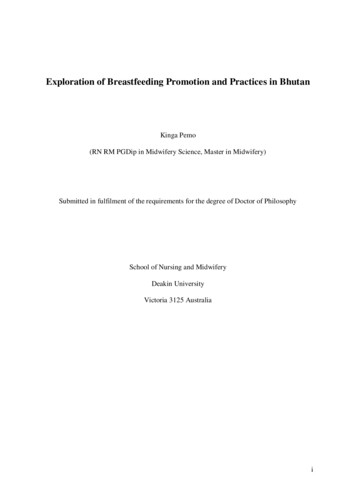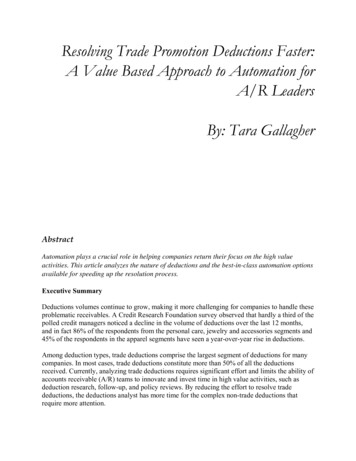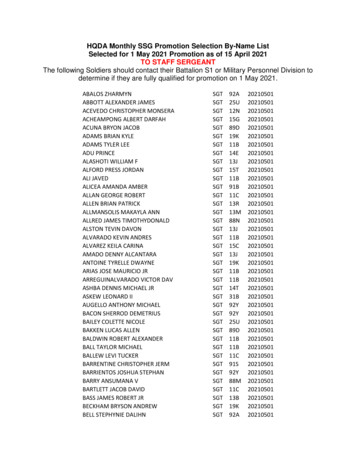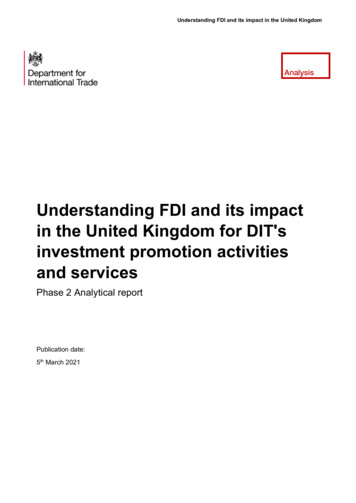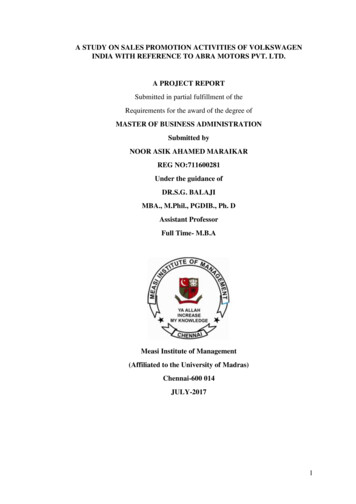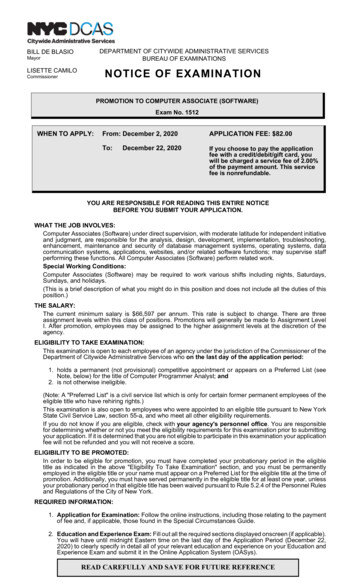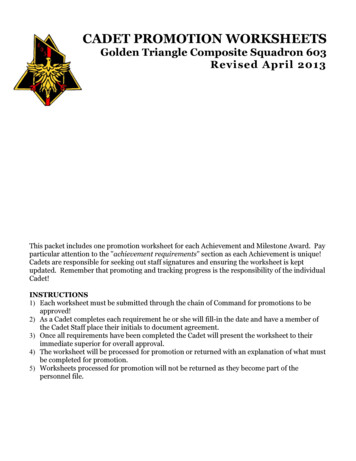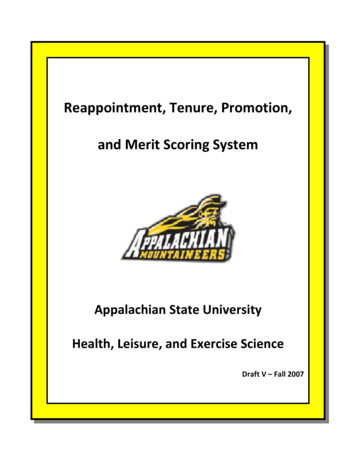
Transcription
Reappointment, Tenure, Promotion,and Merit Scoring SystemAppalachian State UniversityHealth, Leisure, and Exercise ScienceDraft V – Fall 2007
Draft V RTPM Scoring SystemPage 1 of 32RTPM Scoring System Overview- ASU. HLES -IIRTPMScoringSystemOverviewThis document outlines a scoring system used for quantifying professional activities and making administrativedecisions based on varying levels of professional engagement and productivity. Three major performance areas are identified:1. Teaching,2. Scholarship, and3. Service. Each performance area has been weighted according to predetermined departmental standards for full timetenure track and special faculty appointments (i.e., lecturers, practitioners-in-residence, etc.):Performance Area1.2.3. TeachingScholarshipServiceTenure Track Faculty40 %30 %30 %WeightSpecial Faculty Appointment80 %-----20 %A minimum yearly point criterion for each performance area has been established at 70% of the weightedvalues from above. The minimum yearly point criteria are as follows:PointsTenure Track FacultySpecial Faculty Appointment1. Teaching28562. Scholarship21-----3. Service*2114* The minimum yearly point criterion for service is 14 for first-year assistant professors.Performance Area Activities and corresponding point values and criteria have been established and are categorized by the threemajor performance areas:1. Teaching – see Tables 1 – 3,2. Scholarship – see Tables 4 – 19, and3. Service – see Tables 20 – 25.
Draft V RTPM Scoring SystemPage 2 of 32TenureProtocol The teaching, scholarship, and service criteria outlined below are intended to serve as guidelines for theDepartmental Personnel Committee (DPC) in the tenure process. In addition to these criteria the “FacultyHandbook” states that institutional need and collegiality must also be considered in the tenure process. It isimportant to note that the DPC acts in an advisor capacity and tenure decisions are made by the Dean of Fineand Applied Arts. By the end of the 5th year of tenure-track employment the faculty member is expected to demonstrateeffective teaching, productive participation in scholarship, and active engagement in service by accumulating350 points. The minimum criteria for each performance area is as follows:1.2.3. Teaching – 140 pointsScholarship – 105 pointsService – 105 pointsWhile accumulating the 350 points, minimum criteria must be met for each of the three performance areasas follows:1. Teaching From the IDEA, an adjusted summary evaluation score in the middle 40% (45 – 55) during boththe fourth (4th) and fifth (5th) years of tenure track employment. Participation in at least two (2) teaching enhancement activities.2.Scholarship Five (5) refereed publicationsst¾ with at least three (3) at the Beta level as sole, first (1 ) or co-author3.Service One (1) leadership role in an institutional matter.
Draft V RTPM Scoring SystemPage 3 of 32PromotionProtocolPromotion to Associate Professor The criteria for promotion to associate professor are identical to the criteria outlined for tenure (see TenureProtocol section).Promotion to Full Professor To be promoted to full professor it is expected that the candidate, in addition to meeting the minimum criteriaestablished in the “Faculty Handbook”, will demonstrate effective teaching, productive participation inscholarship, and active engagement in service by accumulating 700 points by the end of the 10th year of fulltime employment. The minimum criteria for each performance area are as follows:1.2.3. Teaching – 280 pointsScholarship – 210 pointsService – 210 pointsIn addition, minimum criteria for accumulating points must be met for each of the three performance areas asfollows:1. Teaching From the IDEA, an adjusted summary evaluation score in the middle 40% (45 – 55) during bothof the years preceding consideration for promotion. Participation in at least four (4) teaching enhancement activities.2.ScholarshipAt least three (3) activities in any combination from the activities listed below: Alpha level, refereed publication as first (1st) or second (2nd) author, Alpha level funded grant as first (1st) or second (2nd) investigator, Alpha level book as first (1st) or second (2nd) author, Alpha level editorship3.Service Distinguished leadership role in the discipline. Once promoted to full professor, the faculty member would have the opportunity to negotiate a percentagereallocation in each of the performance areas (teaching, scholarship, and service). The range for reallocatingpercentages for each performance area is as follows:1. Teaching, 40 – 60%2. Scholarship, 10 – 40%3. Service, 10 – 40% The minimum percentage for each performance area cannot be less than the minimum value of each range.The percentage values for each performance area must be in intervals of 10.When added, the percentages for each of the three performance areas must equal 100.To determine a minimal point criterion once the percentages for each performance area are established, thepercentage for each performance area would be multiplied by 70%. (i.e., teaching 50% X 70% 35 points).The established percentages would be in effect for a period of three academic years.Near the conclusion of each three-year period, a full professor would have the opportunity to renegotiate thepercentage allocations to each of the three performance areas.
Draft V RTPM Scoring SystemPage 4 of 32Raise &MeritProtocolRaise & Merit System Overview The raise and merit system is used to reward professional productivity. To objectively determine anappropriate raise a performance score must be calculated. The performance score represents a facultymember’s contribution to the area, department, university, profession at-large, and so forth. Accordingly, thegreater one’s contribution, the higher the performance score. The raise and merit system consists of threecategories as indicated below:1. Basic Raise,2. Merit, and3. HLES Departmental Discretionary MeritAllocation of Money to the Raise & Merit Pool The chair will divide the total amount of money that is allocated for raises and merit among the threecategories as follows:1. Basic Raise – 50%2. Merit – 45%3. HLES Departmental Discretionary Merit – 5% For example, if the total allocated for raises and merit is 50,000, then the dollar value for each category is asfollows:1. Basic Raise – 25,0002. Merit – 22,5003. HLES Departmental Discretionary Merit – 2,5001. Basic Raise All faculty members are expected to make a basic contribution to their area, department, etc. by engaging inprofessionally relevant activities in each of the three major performance areas: teaching, scholarship, andservice. To earn an area basic raise it is expected that the faculty member demonstrate effective teaching,productive participation in scholarship, and active engagement in service by accumulating 70 points duringthe academic/fiscal/calendar year. To earn a basic raise an individual must meet minimum point criteria ineach of the three performance areas. The minimum criteria for each performance area are as follows:PointsTenure Track FacultySpecial Faculty Appointment1. Teaching28562. Scholarship21-----3. Service*2114* The minimum yearly point criterion for service is 14 for first-year assistant professors.Performance Area 50% of the money allocated to raises and merit is reserved for basic raises.The money allocated to the basic raise pool will be divided equally among all individuals who meet theminimum point criteria in each of the three performance areas.For example, if there were 25 faculty who meet the basic raise criteria and the money allocated to the basicraise pool is 25,000, then each faculty member would receive a 1000 raise.
Draft V RTPM Scoring SystemPage 5 of 322. Merit Merit is used to reward those individuals who exceed a basic contribution to their area, department, etc. andearn more than the minimum point criteria in each of the three major performance areas. 45% of the money allocated to raises and merit is reserved for merit. For example, 22,500. This 45% is sub-divided into the following categories: teaching (40%), scholarship (30%), and service (30%).For, example: teaching 9,000, scholarship 6,750, and service 6,750 Any points exceeding the minimum yearly point criteria are applied toward merit within the category inwhich the points are earned. For example, the minimum yearly point criterion for teaching is 28 points. If anindividual earned 38 points for teaching, then 10 points are applied to teaching merit. To calculate merit in each of the three performance areas, merit points for the department are totaled withineach category. Then each individual earns a share of the money in each performance area equal to thecorresponding percentage of points they earned in each category. For example, if an individual earned 10points in the teaching merit pool, and the total number of points in that category is 200, and the total amountof money allocated to that pool is 9,000, then the individual earns a 450 teaching merit raise. A three-year moving average is used to determine merit scores for any given academic/fiscal/calendar year.For example, each year’s merit scores would be calculated by using the current scores and the two previousyear’s scores.3. HLES Departmental Discretionary Merit 5% of the money allocated for raises and merit is reserved for discretionary purposes. For example, 2,500 Individuals are eligible to receive area discretionary merit raises only if they exceed the area basic raisecriteria. The area discretionary merit money is distributed to individuals within the area at the discretion of the chair. Possible uses include, but are not limited to1. Exceptional performance by faculty2. Activities not yet assigned a point valueHow Points for Activities are Determined Points for activities are based on a number of factors including: Professional judgment, Impact of activity on profession, Quality of activity, Rigor necessary to complete activity, Value of activity as a percentage of overall points required for basic contribution in the performancearea, and Norm-referenced comparison of activity to other activities within the same performance area. If an individual engages in an activity that is not yet identified, a point value will be assigned to the activityby the Chair based on: Professional judgment, Impact of product on profession, Quality of product, Rigor necessary to develop product, Percentage of overall points required for basic contribution in the performance area, Norm-referenced comparison of product to other activities within the same performance area, Written justification from the individual who developed the product suggesting a point value.
Draft V RTPM Scoring SystemPage 6 of 32RaiseExample The following example assumes: A 5% annual raise; That the average annual salary in the department is 50,000.00; That there are 30 full time tenure track and special appointment faculty members in the department; That the total dollar amount allocated for raises in the department is 75,000.00 ( 50,000 X 30 X .05); Basic Raise pool 37,500.00 (50% of total merit pool) Merit pool 33,750.00 (45% of total merit pool) Teaching 13,500 (40% of merit pool) Scholarship 10,125 (30% of merit pool) Service 10,125 (30% of merit pool) Discretionary merit pool 3,750.00 (5% of total merit pool) Each of the 30 faculty members in the department scored at least 70 total points each ( 28[teaching], 21[scholarship], and 21 [service]) and earned a basic raise; therefore all of the funds in thebasic raise pool will be distributed equally to each of the 30 faculty members as a 1,250.00 raise( 37,500.00/30)Dr. Jane Doe earned 100 merit points during this past academic/fiscal/calendar year, with a teaching scoreof 35, a scholarship score of 33, and a service score of 32.To receive a basic raise she needed to earn at least 70 points, with a minimum teaching score of 28, aminimum scholarship score of 21, and a minimum service score of 21. Dr. Doe will receive a basic raise of 1250.00 ( 37,500.00/30).A three-year moving average is used to determine her merit points for this academic/fiscal/calendar year.Dr. Doe earned 30 merit points during this academic/fiscal/calendar year, which is the difference betweenher total merit score and the 70-point minimum basic raise criterion.For this year, merit point totals in each performance area for Dr. Doe are as follows: Teaching 7 (35-28),Scholarship 12 (33-21) and Service 11 (32-21)Assuming that in each of the past two academic/fiscal/calendar years, Dr. Doe earned the following meritpoints in teaching 10 and 7, in scholarship 10 and 8, and in service 7 and 9 respectively.Her merit score, which will be used to determine her merit raise, for teaching is 8 ([7 10 7] / 3), forscholarship is 10 ([12 10 8] / 3), and for service is 9 ([11 7 9] / 3).Assume that the total number of merit points for the department in teaching is 250, in scholarship is 200, andin service is 300. In teaching each merit point is worth 53.00 ( 13,500/250). In scholarship each merit pointis worth 50.60 ( 10,125/200). In service each merit point is worth 33.75 ( 10,125/300).Dr. Doe’s merit raise is as follows: Teaching 424.00 ( 53.00 X 8 points), Scholarship 506.00 ( 50.60X 10 points), Service 303.75 ( 33.75 X 9 points).Dr. Doe had an exceptional academic/fiscal/calendar year and engaged in an activity that brought greatprestige to the department. However, the activity was not yet identified on the list of professional activities.Since she met the criteria for a basic raise she was eligible for a discretionary merit raise. Therefore, at thediscretion of the chair, Dr. Doe received an additional discretionary merit raise of 200.00.In summary, Dr. Doe earned a total raise of 2,683.75. Her raise is itemized below: Basic Raise 1,250.00 Merit 1,233.75 Area Discretionary Merit 200.00
Draft V RTPM Scoring SystemPage 7 of 32RTPM Scoring SystemPerformance Area 1. Teaching- ASU. HLES -IIIOverviewTeachingRTPM scores for teaching are based on Teaching Enhancement Activities (Table 1), Teaching Effectiveness (Table 2), and Teaching Honors & Awards (Table 3).To determine points for teaching effectiveness please refer to the IDEA Diagnostic Form Report:To calculate your overall teaching effectiveness score 1. Identify your adjusted summary evaluation T-score for each course that you teach2. Add the scores for each course and divide by the number of courses. This is your average teachingeffectiveness T-score.3. Use Table 2 to determine the number of points that correspond with your average teaching effectivenessT-score from step 2. This number represents the points you earned for teaching effectiveness.How Teaching Effectiveness RTPM Points are Determined (Table 2) T-score categories and ranges are those specified on the IDEA Diagnostic Form Report: The categories and ranges include: Highest 10% ( 63), Higher (56 - 62), Similar (45 - 55), Lower Average (38 - 44), and Much Lower ( 37). To determine a reasonable point value that corresponds with each T-score the following steps werecompleted1. First, an average point value for teaching must be established. This value is based on the predetermined departmental standard of 40% for teaching. To calculate an average teaching score onewould multiply the departmental standard (40) by an average score (70%). Thus an averageteaching score would be 28 points (40 X 0.7).2. Next, T-scores and point values were matched. Initially, the T-score of 45, which represents thefirst score in the Middle 40% category, was matched with the average point value (28) calculated instep 1.3. Finally, each T-score above and below 50 was assigned a corresponding point value above or below28 in one point increments. (i.e., 46 29 and 44 27).
Draft V RTPM Scoring SystemPage 8 of 32Teaching ActivitiesTeachingEnhancement ActivitiesPoints443322110.5211342222Table 1ActivityNational/Regional/State Coursework for Credit – on siteNational/Regional/State/University Coursework for Credit – distance learningUniversity Sponsored Coursework for Credit – on siteNational/Regional/State Multi-day Workshop ParticipationUniversity Sponsored Multi-day Workshop ParticipationNational/Regional/State Full day Workshop ParticipationUniversity Sponsored Full day Workshop ParticipationNational/Regional/State Partial-day Workshop ParticipationUniversity Sponsored Partial-day Workshop ParticipationIndividual Growth Plan – Based on HLES Peer Observation & IDEA dataExtended invitation to qualified observerObservation of effective teacherDesign & Development of a New Course via AP&PChair, Thesis CommitteeMember, Thesis CommitteeReader, University Honors ProgramDirector, Student ProjectOtherCriteriaParticipation inactivity can bedocumented.Written actionplan indicatinghow activity willbe used toenhance teachingeffectiveness.
Draft V RTPM Scoring SystemPage 9 of 32To find your TScore locate theAdjustedSummaryEvaluationScore for yourDisciplineTeaching EffectivenessIDEACategoryAverageT-ScoreMuch 50494847464544434241403938Table iteriaFull Professor(Negotiated)IDEAadministered inevery class thatyou teachIDEAadministrationadheres to theprotocol outlinedby the HLESTeachingEnhancementCommittee.Scores above andbelow the highestand lowest scoresillustrated on thetable earn pointsin one pointincrements. Forexample, a Tscore of 19 wouldearn 36 pointsand a T score of18 would earn 35points, etc.
Draft V RTPM Scoring SystemPage 10 of 32Much Lower372047
Draft V RTPM Scoring SystemPage 11 of 32TeachingHonors & rsityCommunityTable 3Criteria Honor or award can be documented.
Draft V RTPM Scoring SystemPage 12 of 32RTPM Scoring SystemPerformance Area 2. Scholarship- ASU. HLES -IVOverviewScholarshipRTPM scores for scholarship are based on the following major activities Publications (Tables 4 - 6), Presentations (Tables 7 - 10), Professional Editor/Reviewer (Tables 11-16). Granstsmanship (Tables 17 - 18), Other (Table 19), and Scholarship Honors & Awards (Table 20).ScoresIn most cases within a single category, points are allocated based on progressive levels of responsibility. Theallocation of points are based on the following percentages: 100% - highest level of responsibility (ex. 1st author – 30 points) 70%- 2nd highest level of responsibility (ex. 2nd author – 21 points) 40%- 3rd highest level of responsibility (ex. 3rd author – 12 points) 15%- 4th highest level of responsibility (ex. 4th author – 4.5 points)Faculty who co-author publications and/or co-present may choose to divide credit equally.First-Year Assistant Professor Scholarship MatriculationIn order to aid first-year assistant professors in initiating a cycle of scholarship, a percentage of the total pointsallocated to the activity will be credited for submissions in each of the following major scholarship activities:publications, presentations, and grantsmanship. The criteria for giving credit for submissions in any of theidentified scholarship activities is as follows: The individual is a first year assistant professor33% of the points allocated to a scholarship activity will be awarded for submission of the activityIf the scholarship activity is published, presented, or funded, then the individual will receive the remainingpoints (66%) allocated to the scholarship activity.
Draft V RTPM Scoring SystemPage 13 of 32PublicationsRefereedTable 4Alpha LevelPoints30Authorship1st212nd123rd4.5 4thCriteriaHigher tiered peer reviewed journal in discipline as evidenced by: Higher rejection rate, Higher circulatio
of 35, a scholarship score of 33, and a service score of 32. To receive a basic raise she needed to earn at least 70 points, with a minimum teaching score of 28, a Draft V RTPM Scoring System

